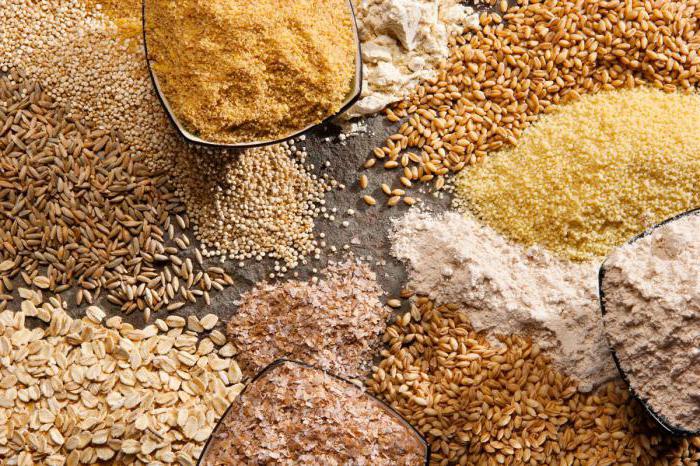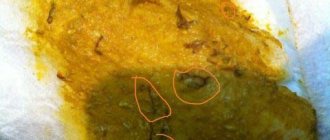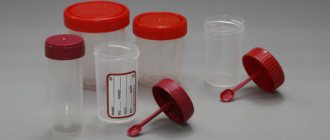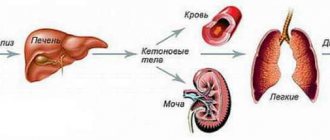What is a coprogram
Coprogram (or coprolgia) is a study of feces in order to determine their physical and chemical composition, as well as the presence of abnormal inclusions, to clarify and confirm a particular disease, as well as to determine the dynamics of the development of the disease and prescribe effective therapy.
Fecal contents are formed when a bolus of food (chyme) moves from the oral cavity to the anal canal along the digestive tract. In the stool you can detect particles of undigested foods, fecal pigments, epithelial cells of various areas of the intestine, various microorganisms, and determine their content and quantity. Having carefully examined the appearance of stool, its contents, the presence or absence of mucus, properties and composition, chemical, biochemical and physical indicators, the laboratory technician will make an appropriate conclusion, on the basis of which the attending physician will most accurately determine the cause of the disease and prescribe the most effective treatment.
When is a coprogram prescribed?
Stool examination is necessary to obtain complete information about the functioning of the digestive organs. Therefore, the coprogram is prescribed for diseases of the gastrointestinal tract, dysfunction of the digestive system, disorders of the pancreas, disorders of bile production and neoplasms in the intestines.
Indications for a coprogram are also the presence of the following problems:
- pathological processes of the gastrointestinal tract;
- diseases of the duodenum,
- parasitic infections of the body, including helminthic infestations,
- inflammatory and infectious processes,
- dysfunction of the pancreas, liver and gallbladder,
- oncological diseases of internal organs.
It is recommended to carry out a coprogram several times: before treatment - to identify the cause of the disease and confirm the diagnosis, and after treatment to determine how effective the therapy was.
Also, scatological studies make it possible to identify dysbacteriosis, characterized by a violation of the ratio of normal and pathogenic microorganisms, in which a significant increase in the latter is observed.
How to prepare for research
If a coprogram is prescribed in advance, you should properly prepare for the test and eliminate factors that may affect the accuracy of the test. Therefore, before collecting the test material (stool), you need to adhere to a certain diet, excluding fatty, smoked, and salty foods from the diet. There are also restrictions on the use of certain medications, for example, laxatives and antibacterial agents. Women's critical days can also change the “correctness” of the analysis, so you should not take stool for analysis during menstruation. The reliability of the study is also affected by the enema performed before stool collection. Therefore, it should be remembered that the collection of material for coprogram is carried out only after natural bowel movement.
Before collecting stool, you need to perform hygiene procedures, urinate (empty the bladder), use detergents to toilet the intimate areas, and then rinse the genitals and anus with warm (preferably boiled) water.
The material for research is collected in a special sterile container (it is sold in pharmacies). For convenience, a small spatula is attached to the lid of the container to catch feces. For the objectivity of the study, you need to take several stool samples from different parts of it. The total volume of material for analysis should be about half a teaspoon.
Preparing for analysis
In order for the results to accurately reflect the state of digestion and be as informative as possible, the patient must strictly follow the requirements for preparing for the analysis and submitting stool. So, a couple of days before collecting the material, it is proposed to exclude the following foods from the diet:
- beets;
- fatty fish;
- green vegetables;
- meat and meat-containing products;
- tomatoes.
Before collecting material, it is better to eat cereals, dairy products, vegetable purees and fruits. Immediately before collecting stool, you need to thoroughly wash your genitals and anus. Women during menstruation are not advised to donate stool. If 7-10 days before the expected delivery of stool, an X-ray contrast examination of the gastrointestinal tract with barium or an enema was performed, the coprogram and, accordingly, the collection of material are postponed.
Patients who have been prescribed a test are often interested in how to properly collect stool for coprogram. In order for the information in the calogram to be as accurate as possible, the material must be collected according to certain rules:
- Bowel movements should be spontaneous. The use of enemas and laxative medications to stimulate bowel movements is strictly prohibited, as they can distort the qualitative composition of feces.
- The material should be collected in such a way as to prevent menstrual blood or urine from getting into it.
- To transport stool to the laboratory, use a specialized sterile container, purchased in advance from a pharmacy. To conduct the study, only one teaspoon of material is needed, so there is no need to completely fill the container.
- Feces may be collected throughout the day. That is, it is not required to take it on an empty stomach. It is necessary to send the material for research no later than 12 hours from its collection. It is allowed to store collected feces in the refrigerator (below 8 degrees).
When collecting feces from a child, you need to take care of the cleanliness of the potty. In this case, care should be taken to ensure that no other biological fluids get into the material. It is impossible to stimulate defecation, in addition, it is worth removing coloring and fatty foods from the baby’s menu, as this can distort the consistency, color and show the incorrect chemical composition of the poop. The physician should be made aware of any medications the child is taking so that any medications that may alter the results should be discontinued before collecting stool.
To collect feces from infants (provided they have loose stools), parents should use an oilcloth or diaper. Collecting material from diapers is not encouraged.
In case of constipation, the baby is given a abdominal massage or a gas tube is used. These methods stimulate bowel movements.
Stool sampling in children
If it is necessary to examine the stool of children, the sampling algorithm is similar to that described above.
If your child knows how to use a potty, wait until he has a bowel movement and then collect some of the stool in a special container. But do not forget, before putting your baby on the potty, thoroughly wash the container with detergent, then treat it with boiling water and wipe dry.
To collect feces from a baby, you need to use reusable diapers or oilcloth and wait until the baby has emptied his bowels.
To get reliable results, do not allow urine to pass into your stool. To do this, you can use special urinals that are attached to the baby’s body in the genital area. During the toilet, urine will be collected in a specially designated place and will not affect the quality of the material being tested. If it is difficult to collect your baby's stool for analysis, try doing this using a urine bag. Naturally, it will need to be attached in the area of the anus.
Rules for collecting material
There are several simple rules that must be taken into account when submitting material for this analysis:
- If the patient is taking iron supplements or products containing bismuth, they will have to be stopped. In addition, you should not use laxatives or rectal suppositories. You cannot rinse the intestines with an enema.
- If the patient has undergone contrast radiography, then stool analysis can be carried out no earlier than seven to ten days after this, since barium can change the properties of stool.
- For several days before the analysis, you should exclude exotic dishes.
- Forty-eight hours before submitting the material, you will need to exclude beets, tomatoes, tomato paste and juice, as well as other products with dyes.
- Seventy-two hours before, you should stop taking antibiotics and enzymes.
- The diet should include cereals, fruits, dairy products, and vegetables. You shouldn't overeat.

- It is necessary to limit spicy, smoked, pickled, fatty foods.
- During menstruation, the coprogram does not give up.
- Stool collection should be organized so that urine does not get into the material.
- Evacuation of feces for collection should be natural, without the use of enemas or stimulants.
DETAILS: What is fetal CTE on ultrasound during pregnancy?
In order for the results of the coprogram to be most effective, you must acquire a special sterile container for collecting feces (the required amount is two teaspoons). You can buy such a jar at any pharmacy. You can also collect stool from infants to perform a coprogram. It is necessary to take the material from the diaper, because diapers absorb liquid and the result will be distorted.
Analyzes must be fresh. Only in exceptional cases can the jar be tightly covered with a lid and left in a cool place. Only in time no more than 6 hours. The collected stool should be free of urine and other impurities.
In order for the coprogram to show reliable results, you must adhere to the following rules:
- two days before collecting the material, stop taking medications - they can affect the digestive processes and stool, and greatly distort the results of infants;
- 4 days before collecting the material, take butter, cereals, bread, eggs and dairy products as the basis of the child’s diet;
- Before analysis, minimize the child’s consumption of fruits and vegetables. The ban also applies to meat, fish and greens.
To conduct research, it is enough to bring part of the baby’s excrement to the laboratory. Modern diagnostic equipment allows you to evaluate the material in an amount of 1 tsp.
Feces must be fresh. It is advisable that the bowel movement occur in the morning, which will minimize the hours of delivery of excrement to laboratory technicians. As a last resort, the resulting material can be stored in a sealed sterile container at a temperature not exceeding 50 °C for 6 hours.
Rules for collecting stool from newborns:
- prepare a disposable spoon and a sterile container with a lid (you can purchase a special container at the pharmacy);
- remove the baby’s diaper (since it partially absorbs liquid, this can shift the test results) and wash the baby;
- put the baby on a clean diaper and wait for a bowel movement (baby stool is usually soft, with a porridge-like consistency);
- collect feces for analysis using a spoon or spatula in the required quantity.
Older children can be put on the potty by pouring boiling water over it beforehand and drying it. Feces should be collected from 4-5 different places, making sure that no urine gets into it. In some cases, the entire volume of stool produced needs to be assessed.
If parasites (worms) are visually detected in the stool, they must also be placed in a container along with the stool. This will allow you to accurately determine the type of helminthic infestation and correctly select treatment.
You should think about having a coprogram if the baby suffers from constipation or diarrhea or defecates with pieces of undigested food. However, parents should remember that the attending physician must decipher and interpret the results obtained.
Fecal analysis helps to identify inflammatory and infectious processes in the digestive organs, diagnose diseases of the liver and pancreas, reveal parasitic infestations, recognize pathologies of the stomach, duodenum, cecum, colon, small intestine, as well as evaluate the effectiveness of the treatment and adjust it if necessary .
What will the results of scatology tell you?
- When examining the results of a coprogram, comparing the obtained indicators with the norm, it is possible to identify dysfunction of the gastrointestinal tract and internal organs. In particular, the following are assessed:
- microbiological indicators of the intestine,
- enzymatic activity of the pancreas,
- speed of food passage,
- digestive ability of the stomach and intestines,
- pathological changes in the digestive organs,
- the presence of parasites in the body,
- possible inflammation and bleeding.
With repeated coprogram, the effectiveness of the selected treatment methods and prescribed therapy is determined.
The coprogram reflects research on a large number of indicators, understanding which is actually not as difficult as it seems at first glance. The prepared research table usually indicates such parameters as indicator, result and norm.
When studying the properties of feces, the main attention is paid to the following microscopic parameters:
- soluble protein,
- blood,
- slime,
- stercobilin,
- bilirubin,
- iodophilic flora,
- neutral fat,
- soap,
- connective fibers,
- starch (extracellular and intracellular),
- muscle fibers,
- fatty acid,
- vegetable fiber,
- leukocytes,
- detritus,
- ammonia,
- yeast mushrooms,
- helminth eggs.
As part of a macroscopic study, they study:
- shape,
- color,
- consistency,
- smell,
- reaction to occult blood.
Reasons for possible deviations
If the results of the analysis do not correspond to the norm, then depending on which indicator is violated, there may be different interpretations of the reasons for this.
Consistency and shape. Depends on water content. The shape of stool that resembles “sheep feces” indicates excessive binding of water due to constipation. Band-shaped stool may indicate intestinal stenosis. Paste-like stool can be caused by problems with the functioning of the gallbladder, and bubbly stool indicates the presence of an intestinal infection.
DETAILS: Breathing helic test: preparation and conduct
Amount of feces. If there is a large volume of feces, the doctor may suspect enteritis, cholecystitis, obstructive jaundice, Crohn's disease, diarrhea, or dyspepsia in the child. If the amount of stool is too small, the doctor suspects constipation, myxedema, or chronic colitis.
Smell. Depends on compounds such as skatole and indole, which are formed during the breakdown of proteins. As protein decay intensifies in the intestines, the smell becomes stronger. The predominance of plant and dairy products helps reduce odor.
Color. Depends on stercobilin, formed from bilirubin under the influence of intestinal bacteria. Color is also influenced by food, medicinal substances, and pathological impurities.
- If the stool has a pronounced brown color, then this may be a consequence of a large amount of protein in the food, hemolytic jaundice, putrefactive dyspepsia. Also, dark color of stool can be caused by colitis or constipation.
- Light brown feces are an excess of plant foods in the diet or excessively rapid evacuation of the fecal bolus.
- The admixture of green stool is explained by the large amount of greens in the diet.
- Light yellow stool suggests dyspepsia or pancreatitis, as well as an excess of dairy products in the child’s diet (this is the norm for breastfed infants).
- Very dark color of stool, even black, can be caused by bleeding from the stomach and upper intestines. Stool also turns this color when taking iron supplements or foods with a coloring effect (for example, some berries).
- Dark stool with a greenish tint is a sign of a gastrointestinal infection.
- The atypical white color of off-white stool is a consequence of hepatitis, blockage of the bile ducts, and pancreatitis. Transparent, cloudy stool may indicate cholera, while a yellowish-green color may indicate typhoid fever.
- A red tint to the stool indicates possible bleeding from the lower intestines, consumption of foods with dyes, or ulcerative colitis.
Environmental reaction. If the coprogram is alkaline and pronounced, then dyspepsia is suspected due to increased rotting of protein foods, and an acidic reaction occurs due to the presence of organic acids in the biomaterial. A moderately acidic environment is most often due to the presence of fatty acids and may indicate obstructive jaundice, inflammation of the small intestine, and an acidic environment indicates fermentation processes in the large intestine as a result of dyspepsia and dysbacteriosis.
Presence of mucus. If there are large inclusions of mucus with flakes, there is a suspicion of:
- inflammatory process;
- malabsorption syndrome;
- lactase deficiency;
- cystic fibrosis;
- abnormal bends in the intestines;
- celiac disease;
- irritable bowel syndrome.
The presence of blood in the stool. Talks about possible damage to blood vessels, muscle tissue, severe inflammation, polyps, neoplasms, hemorrhoids, proctitis, fissures, colitis, Crohn's disease.
Reaction to bile acids. If the level of stercobilin is elevated, hemolytic anemia or increased bile secretion is suspected. With a lack of stercobilin, hepatitis, pancreatitis, and gallbladder pathologies are possible. If bilirubin is present, doctors suspect problems with intestinal microflora.
Reaction to soluble protein. If present, inflammatory processes in the intestines, bleeding, celiac disease, ulcerative colitis, putrefactive dyspepsia are suspected.
Plant fiber. If digestible fiber is included in the stool, doctors suspect dyspepsia (putrefactive or fermentative) in the child.
Detritus. A low indicator generally indicates poor digestion of food.
Muscle fibers. If altered fibers are detected, then there is a suspicion of insufficient functioning of the pancreas, stomach, poor functionality of the small intestine, or rapid evacuation of food from the body.
Leukocytes. With an increased number of neutrophils, proctitis, colitis, intestinal tuberculosis, paraproctitis, and enteritis are suspected. In the presence of eosinophils, there may be helminthic infestation, amoebic dysentery, colitis (allergic or nonspecific ulcerative).
Neutral fat, fatty acids and soaps. If there is a lot of neutral fat in the coprogram, then this indicates insufficiency of the pancreas or liver. It is possible that there is a blockage in the biliary tract, or the bolus of food is not sufficiently digested in the small intestine.
A significantly increased amount of fatty acids indicates dyspepsia, problems with the functioning of the pancreas, diarrhea, and fermentative dyspepsia. Soaps in coprogram (with the exception of bottle-fed children) may be present in cases of impaired absorption in the intestines, problems with bile production, or pancreatitis.
DETAILS: Nutrition for high blood sugar - allowed and prohibited foods
Starch. If there are intracellular or extracellular inclusions, this indicates a pathology of the digestive organs. Problems with the pancreas are usually suspected, since starch appears when carbohydrates are insufficiently digested, especially with this pathology, extracellular starch is high. There may be suspicion of gastritis, fermentative dyspepsia or diarrhea.
Connective tissue. The presence of connective tissue in stool indicates a deficiency of hydrochloric acid.
Iodophilic flora. If bacteria in the coprogram are present above normal, the child begins to develop fermentative dyspepsia.
Presence of pus. It is a sign of an inflammatory process in the intestines.
Decoding the results
The absence of soluble protein, blood, iodophilic flora, bilirubin, neutral fat, muscle and connective fibers, fatty acids, plant fiber, detritus, yeast fungi and helminths in stool analyzes is normal. A slight presence of mucus, connective and muscle fibers, leukocytes and soaps is also allowed. In infants and newborns under three months of age, small amounts of bilirubin and neutral fat may be observed. Normal research indicators include a content of 20-40 mol/kg of ammonia, and from 75 to 350 mg (daily dose) of stercobilin.
Deviation from the norm indicates possible problems. Thus, the presence of soluble protein indicates possible inflammation of the mucous membrane, polyps and neoplasms. Particles of blood indicate internal bleeding in the intestines. An excess amount of mucus indicates inflammatory processes in the intestines and infections in the intestines. An increased content of stercobilin indicates bleeding and resulting anemia; a value below normal indicates obstruction of the bile ducts. The presence of bilirubin in the stool indicates disturbances in the rate of digestion and passage of food, dysbacteriosis and acute inflammation.
The presence of neutral fat indicates disturbances in bile secretion and lipolytic function of the pancreas; muscle and connective fibers indicate a decrease in the secretory function of the pancreas and stomach. Starch indicates problems with the small intestine, the presence of iodophilic flora and yeast indicates dysbiosis. An increased concentration of soaps indicates inflammation of the pancreas and the possible formation of gallstones. Leukocytes and an increased amount of ammonia indicate inflammatory processes in the intestines, fatty acids indicate a dysfunction of bile secretion. The presence of helminth eggs in the feces indicates a parasitic infestation.
Digestible and indigestible plant fiber in feces
Plant fiber belongs to the group of polysaccharides (complex carbohydrates), which are the cell walls of plants. It is found in vegetables, fruits, legumes and grains.
Fiber is practically not digested and not absorbed by the body, because the human body does not have digestive enzymes capable of breaking it down. Only some of the fiber can be digested under the influence of beneficial intestinal microflora, while the bulk of it is removed from the body unchanged.
Decipher “General blood test” Decipher “Biochemical blood test” Decipher “General urine test”
Fiber mechanically irritates the nerve endings of the intestinal walls, thereby stimulating peristalsis and promoting the movement of food through the digestive canal, removing undigested nutrients from the body.
Fiber also helps maintain normal intestinal microflora, since bacteria living in the intestines feed on coarse dietary fiber.
Digestible and indigestible plant fiber can be found in feces.
Digestible plant fiber consists of large round cells that have a thin, easily destroyed shell and a cellular structure. The cells of the digestible fiber are interconnected by a layer of pectin, which first dissolves under the action of gastric juice and then in the contents of the duodenum. If there is insufficient amount or absence of hydrochloric acid in the gastric juice, the cells of the digested fiber cannot be separated and appear in the feces in the form of groups (cells of carrots, potatoes, beets). At the same time, the body does not receive nutrients from this fiber completely or does not receive them at all, even when consuming a large amount of fruits and vegetables.
Indigestible fiber includes the skin of fruits and vegetables, the vessels and hairs of plants, the epidermis of cereals, etc. The cells of indigestible plant fiber have thick double-circuit membranes. They contain lignin, which gives fiber its hardness and rigidity. Indigestible fiber is excreted in the feces almost unchanged. Basically, the amount of indigestible fiber depends on the nature of a person’s diet.
In the feces of a healthy person who eats plant foods, digestible plant fiber is not normally found; indigestible fiber is found constantly and in different quantities.
The main reasons for finding large quantities of digestible fiber in feces are a decrease in the acidity of gastric juice, accelerated evacuation from the intestines, and diseases of the pancreas if they are accompanied by diarrhea. If you consume a large amount of fiber, all of it may not have time to be digested and will be found in the feces.
Automatic interpretation of stool analysis (coprogram)










